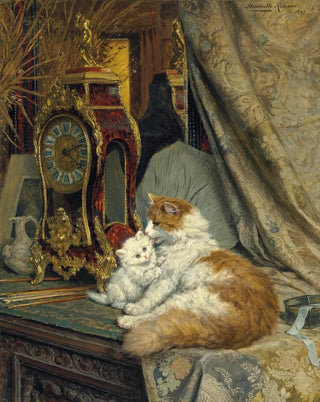Art print | A cat and her kitten with a support clock - Henriette Ronner-Knip Source: Reproduction | Une chatte et son chaton avec une horloge à support - Henriette Ronner-Knip


View from behind

Frame (optional)
Henriette Ronner-Knip’s artwork "A Cat and Her Kitten with a Support Clock" immerses us in a delicate universe where animal tenderness blends with an atmosphere of serenity. This intimate scene, where the feline mother watches over her little one, evokes both the warmth of home and the beauty of nature. The presence of the clock, a symbol of passing time, adds a contemplative dimension to this depiction, encouraging viewers to reflect on the fleeting nature of these precious moments. In this piece, Ronner-Knip manages to capture an essence that is both simple and profound, turning each gaze into an invitation to daydream.
Style and uniqueness of the work
Henriette Ronner-Knip’s style is distinguished by meticulous attention to detail and a palette of soft, soothing colors. In "A Cat and Her Kitten with a Support Clock," every hair of the feline seems to come alive under the artist’s brush, while the nuances of light play across the surfaces, giving the scene an almost tactile depth. The composition is carefully orchestrated, highlighting the relationship between the mother and her kitten, while integrating the clock as a narrative element that enriches the painting. The harmony between the characters and the environment creates an atmosphere of peace, where one can almost feel the heartbeat of nature. This artwork does not merely depict animals; it tells a story— that of an unbreakable bond between a mother and her child, while also evoking a sense of nostalgia for ephemeral moments.
The artist and her influence
Henriette Ronner-Knip, born in 1821 in Amsterdam, is an iconic figure in 19th-century animal painting. Her work is marked by a passion for animals, which she translated with rare sensitivity. Raised in an artistic environment, she was influenced by the great masters of her time and developed a distinctive style that blends realism with tenderness. Ronner-Knip established herself in a world often dominated by male artists, and her work was recognized for its unique charm and emotional depth.

Matte finish

View from behind

Frame (optional)
Henriette Ronner-Knip’s artwork "A Cat and Her Kitten with a Support Clock" immerses us in a delicate universe where animal tenderness blends with an atmosphere of serenity. This intimate scene, where the feline mother watches over her little one, evokes both the warmth of home and the beauty of nature. The presence of the clock, a symbol of passing time, adds a contemplative dimension to this depiction, encouraging viewers to reflect on the fleeting nature of these precious moments. In this piece, Ronner-Knip manages to capture an essence that is both simple and profound, turning each gaze into an invitation to daydream.
Style and uniqueness of the work
Henriette Ronner-Knip’s style is distinguished by meticulous attention to detail and a palette of soft, soothing colors. In "A Cat and Her Kitten with a Support Clock," every hair of the feline seems to come alive under the artist’s brush, while the nuances of light play across the surfaces, giving the scene an almost tactile depth. The composition is carefully orchestrated, highlighting the relationship between the mother and her kitten, while integrating the clock as a narrative element that enriches the painting. The harmony between the characters and the environment creates an atmosphere of peace, where one can almost feel the heartbeat of nature. This artwork does not merely depict animals; it tells a story— that of an unbreakable bond between a mother and her child, while also evoking a sense of nostalgia for ephemeral moments.
The artist and her influence
Henriette Ronner-Knip, born in 1821 in Amsterdam, is an iconic figure in 19th-century animal painting. Her work is marked by a passion for animals, which she translated with rare sensitivity. Raised in an artistic environment, she was influenced by the great masters of her time and developed a distinctive style that blends realism with tenderness. Ronner-Knip established herself in a world often dominated by male artists, and her work was recognized for its unique charm and emotional depth.






